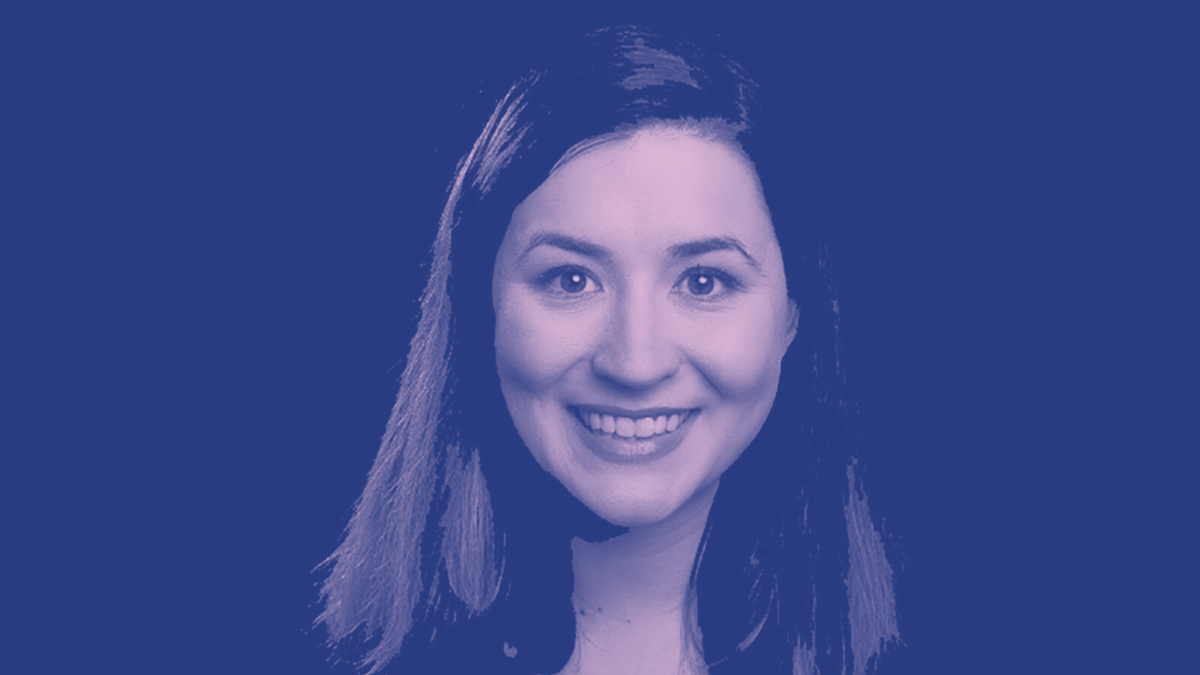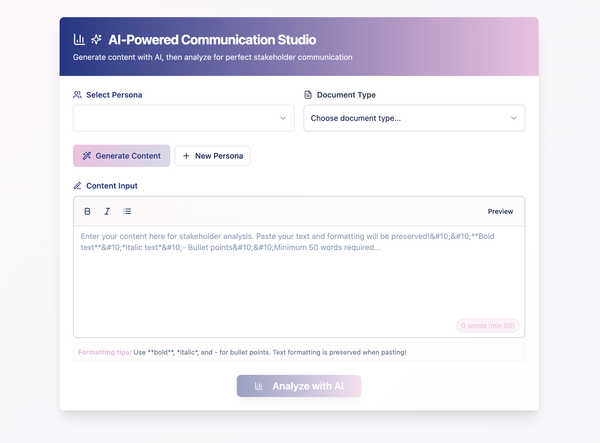The AI Architect Building the Future of Communications at FleishmanHillard
AI expertise isn't about being technically gifted – it's about understanding systems and workflows.

While many comms leaders are still asking 'should we use AI?', Joyce Higgins is already several steps ahead, building custom AI environments that transform how entire teams work.
When Joyce Higgins joined FleishmanHillard, in May 2024, she kept mentioning that AI would fundamentally change how we search for and consume information. "Everyone was like, 'Yeah, I guess that's something we should have on our radar,'" she recalls. Fast forward to today, and as Head of AI Strategy, she's leading transformation across one of the world's largest communications agencies, building custom AI environments that are revolutionising how teams operate.
Here's what makes Higgins different from the countless AI evangelists flooding our LinkedIn feeds: she's not interested in talking about AI, she's interested in building with it. Most importantly, she's interested in teaching others to build with it too.
"You can talk about AI for the next 12 months, but if you haven't built anything, you're not an AI specialist," she states. It's this practical approach – honed through years of building complex digital systems – that's driving real transformation at FleishmanHillard.
The Foundation: From Complex Logic to AI Architecture
Understanding Higgins' approach to AI requires understanding where she came from. Her first major project at Digitas Health was a $10 million TV-driven copay registration card system which integrated CRM channels through complex backend business rules. "We did all of the business rules and marketing operations behind the online and offline mailers," she explains. "To this day, it was one of the most complex marketing projects I've worked on."
This early immersion in data-heavy, logic-driven systems set a pattern. When social media exploded across healthcare clients, Higgins didn't just adopt it – she built the operational procedures from scratch. When she moved to Real Chemistry, she didn't just join their digital team – she built their entire digital activation capability for the London office, including paid media, digital strategy, integrated planning, and measurement teams.
Reality Check #1: "AI expertise isn't about being technically gifted – it's about understanding systems and workflows."
By 2020, she was already working with conversational AI at Real Chemistry, building tools specifically trained on handling healthcare-related questions for niche audience segments. "We had a tool that was specifically trained on handling healthcare-related questions for very niche audience segments, such as medical science liaisons," she notes. This wasn't theoretical exploration: it was a practical application for real clients with real needs.
So at the start of 2025, Higgins was ready to take on her new role FleishmanHillard as their Head of AI Strategy. Not just because she could talk about large language models or explain how neural networks function, but because she understood how to build systems that actually work.

The Framework: Building the AI Comms Toolbox
The centrepiece of Higgins' approach is deceptively simple: the AI Comms Toolbox. But don't let the straightforward name fool you. This is a sophisticated framework that transforms how teams adopt and scale AI capabilities.
"Essentially, it is a suite of agents, the instructions for those agents, and guidance on how to set up the knowledge documents for your average communications account," Higgins explains. Teams receive the complete package, which includes process documentation, testing criteria, agent instructions, knowledge document examples, and six weeks of hands-on support.
The framework operates on a crucial principle that many organisations miss: everyone needs to become AI-capable, but not everyone needs to become an AI expert. "Our strategy is that everyone has to be an AI specialist," says Higgins.
However, this isn't about turning PR professionals into programmers. It's about democratising AI capability across the entire organisation.
Reality Check #2: "People get nervous. They say, 'I don't understand how to manipulate data.' But I explain: you can write digital content, and that's all it is. When you're writing instructions for an agent, it's just describing to someone how something should be achieved."
The toolbox requires teams to implement at least three types of agents:
- An insights agent (for analysis and understanding)
- A content development agent (for creation)
- A review agent (for quality control and compliance)
This isn't arbitrary. Higgins has discovered that most people think of AI purely for content generation, missing its powerful applications in content review and analysis. "We have agents that support any kind of code of practice," she notes. "Not everyone appreciates how valuable it is for content review."
The six-week sprint structure provides just enough support without creating dependency. Week by week, teams progress from nervous newcomers to confident builders. "What we've noticed is it becomes essentially training wheels," Higgins observes. "Something that seemed really scary to them before now seems completely achievable."
The Build: From Theory to Working Systems
Here's where Higgins' approach diverges from typical AI adoption strategies. Rather than rolling out generic tools and hoping teams find uses for them, each account team builds customised solutions for their specific needs.
FleishmanHillard utilises Omnicom's proprietary AI infrastructure, which offers enterprise-level security and enables the development of sophisticated knowledge bases. "It gives us a lot of ability to build out custom knowledge bases for our clients, and then the agents off of the back of it in these really secure sandboxes," Higgins explains. Teams can upload hundreds of documents to create deep institutional knowledge about their clients.
But the technical infrastructure is just the starting point. The real innovation is in how teams learn to think about AI applications. Take virtual audiences, for instance. Instead of relying solely on publicly available data from tools like GWI or Talkwalker, teams are building virtual representations of specific communities using focus group research and qualitative data.
"We found that going out and getting focus group research and data and bringing it back and building virtual audiences to make sure that you're really creating messages that resonate with different audiences and communities is the best way to go about it," Higgins explains. This isn't AI for AI's sake – it's AI solving real communications challenges.
Reality Check #3: "Everyone who is using AI is seeing that it's not saving a huge amount of time. If folks are saying it's saving a huge amount of time, they're probably lifting copy directly from the platform and using it as is, which is not an effective way of using Gen AI."
The value isn't in the time saved, but in the capability gained. Teams can bring more insights to the table, communicate with greater precision, and allocate more time to strategic planning rather than tactical execution. "There's a lot more time for planning and having those strategic conversations, rather than the actual writing of the words," Higgins notes.
The Debugging: Learning from What Doesn't Work
One of the most refreshing aspects of Higgins' approach is her willingness to discuss what doesn't work. In an industry often obsessed with polished case studies, she's forthright about the failures and challenges.
"There are two bad habits of communicators that I always tell the team to please break," she says. The first is the tendency to talk about AI rather than build with it. The second – and perhaps more pernicious – is the need for perfectionism.
"Communicators want precedent. They want to know where we've done it before, and they don't want to show the client anything that isn't perfect," Higgins observes. "But the problem is that you have to show stuff that's not perfect because you don't want to go too far down the line in a build."
This perfectionism paralysis is particularly acute in communications, where professionals are trained to present polished, final versions of everything. But AI development requires an experimental mindset. "You're not going to innovate if there's precedent," Higgins points out.
The debugging process has revealed other crucial insights. When teams first encounter AI tools, many become nervous about the technical requirements. "People were a little bit nervous. It felt a bit scared. It's AI, it's different. I didn't have to do digital before, so why do I have to do this type of digital?"
The breakthrough in breaking down resistance came when Higgins reframed the conversation: "This isn't a digital tool, this is a comms tool."
The Scale: Extension Packs and Exponential Growth
Once teams master the basic toolbox, something remarkable happens: they start building their own solutions. "By the end of our six-week sprint, they're able to start building their own custom agents," Higgins notes. This is where the real transformation occurs – when AI adoption shifts from top-down implementation to bottom-up innovation.
To support this growth, FleishmanHillard has developed what Higgins calls "extension packs" – pre-built modules for specific communications needs:
- Crisis communications agents
- Editorial content systems
- Thought leadership report builders
- IP and intellectual property reviews
- Media relations tools
- Measurement and analytics agents
- Brand voice and tone checkers
- Regulatory compliance reviewers
- Multi-language adaptation tools
- Community sentiment analysers
"When success is really realised is when we notice that an account is so confident in their use of AI that they start to say, 'Okay, for this particular work stream, I need this extension pack, because AI is now just the way that we work,'" Higgins explains.
The modular nature allows teams to mix and match components based on their specific needs. A healthcare client might combine regulatory compliance with community sentiment analysis. A consumer brand might focus on brand voice with multi-language adaptation.
Reality Check #4: "Now is a really forgivable time to be comfortable with experimenting. Say to your stakeholders, 'I was trying something new. It wasn't perfect, but we have a lot of key learnings.'"
The Ethics Architecture: Building Responsible AI
Higgins doesn't shy away from the ethical implications of AI in communications. In fact, she sees communicators as having a unique responsibility in shaping how these tools develop.
"Words and ideas and narratives are the new data," she emphasises. "We don't need to know an additional language to produce any kind of data that's going to train these large language models. Communicators have a bit of a responsibility to make sure that we round out some of the biases that we do see."
This isn't just philosophical musing. FleishmanHillard now has formal AI agreements with clients that detail logging procedures, paper trails, copyright considerations, and QA processes for identifying harm or bias. Teams are trained not just in using AI, but in using it responsibly.
The virtual audiences work exemplifies this approach. Rather than accepting the limitations of publicly available data, teams actively seek out diverse perspectives and underrepresented voices to build more complete representations of their audiences.
The Commercial Reality: Making the Business Case
How do you justify AI investment to sceptical leadership or clients? Higgins has a refreshingly practical approach: show them the money.
"What I have found works the best is bringing a commercial assessment," she says. The team measures specific impacts: speedier content delivery times, junior team members becoming more autonomous, senior team members having more time for strategic planning, and faster onboarding for new team members.
"When you actually do the commercial assessment of how much time is either saved or redistributed to a higher value opportunity, there's very little conversation after that," Higgins notes. "The leadership team always says, 'How do we get this done?'"
But she's careful to set realistic expectations. This isn't about replacing people or dramatically cutting costs. It's about elevating capabilities and redistributing effort to higher-value activities.
The Future Architecture: What's Next
Looking ahead, Higgins is most excited about two developments: collaborative AI environments and predictive analytics for communications.
"The ability to collaborate with clients in a sort of shared environment" is the next frontier, she explains. Imagine combining Omnicom's PR-first tools and data sets with a pharmaceutical company's real-world evidence and audience data. "The ability to match those two types of data sets to create this really comprehensive view of what their audiences are and then build the AI from there is going to be really, really exciting."
Predictive analytics represents another leap forward. "From a comms perspective, I think it's an area where there's more opportunity, especially when we're thinking about how we want to change narratives for our clients, being able to react and adapt to the market and understand how we need to shape the narrative."
But perhaps the most profound change is already here: the expectation of personalisation. "If I go to ChatGPT and it remembers that I have a dog and I like hiking when I go on holiday and I'm travelling with my partner, I may never go read a travel blog post again," Higgins points out.
This has massive implications for communications. "We're so used to creating static, long-form content. We really need to think about these new opportunities to create really personalised experiences for our audiences."
Building Your Own Blueprint
What can communications leaders learn from Higgins' architectural approach to AI transformation?
- Start with systems, not tools: The AI Comms Toolbox works because it's a complete system – processes, training, support, and iteration. Don't just throw AI tools at your team and hope for the best.
- Make everyone a builder, not a user: The goal isn't to have a few AI experts and many passive users. It's to enable everyone to build and experiment within their expertise area.
- Embrace imperfection: "You have to show stuff that's not perfect," Higgins insists. The teams that progress fastest are those that prototype, test, fail, and iterate quickly.
- Measure what matters: Don't focus on time saved – focus on value created. Where is effort being redistributed? What new capabilities have you gained?
- Think modular: The extension pack approach means you can start simple and add sophistication over time. You don't need to transform everything at once.
- Own the responsibility: As communicators, we're not just using AI – we're training it with our words, ideas, and narratives. That comes with an obligation to do it thoughtfully and inclusively.
Joyce isn't interested in the AI hype cycle. She's not waiting for perfect tools or clear precedents. She's building the future of communications, one agent at a time, one team at a time, one experiment at a time.
"Everyone's going to expect to be able to have a dialogue with some sort of interface and get a super personalised experience back to them," she predicts. "We're going to be much more clever about the way we do comms moving forward."
The question isn't whether AI will transform communications – it's whether you'll be one of the architects of that transformation, or just a passenger along for the ride.
As Higgins puts it: "You can talk about AI for the next 12 months, or you can build something."
Which will you choose?
- Connect with Joyce on LinkedIn.
- This interview is part of Applied Comms AI's "Leaders & Learning" series. Sign up for regular conversations with communications leaders navigating the AI revolution, alongside our hands-on comms AI experiments and investigations.
- Applied Comms AI is powered by Faur.




